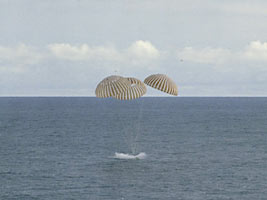| The
flight was launched on April 11, 1970. Disaster struck on
April 13. The spacecraft had reached 85 percent of the
distance to the moon when an oxygen tank exploded, wiping out
the main supply of life-sustaining oxygen and power. People
all over the world responded to the plight of the three
astronauts in the crippled spacecraft.
The
astronauts moved out of the stricken Command Module and into
the cramped quarters of the Lunar Module. The Lunar Module,
built for the short trip for two people to land on the moon,
would serve as the lifeboat for a four-day journey for three
people. Using the Lunar Module's descent engine for
propulsion, the crew looped the spacecraft around the moon and
headed home.

A perilous space flight comes to a smooth
ending with the safe splashdown of the Apollo 13 Command
Module in the South Pacific Ocean, only four miles from
the prime recovery ship, the USS Iwo Jima. The
crewmembers were transported by helicopter from the
immediate recovery area to the USS Iwo
Jima. |
While
each element of the rescue was carefully planned and carried
out, the crew battled cold, fatigue and physical discomfort.
The Lunar Module's 49.5 hours of life support for two people
had to be stretched to 84 hours for three people. With
guidance from JSC spacecraft experts and life-support
engineers, the Apollo 13 astronauts jury-rigged marvels of
ingenuity for survival.
After
splashdown in the Pacific Ocean on April 17, Apollo 13 was
called a brilliant demonstration of the human capability under
almost unbearable stress. At JSC it was known by many as "the
finest hour."
"I look
back on Apollo 13 as an ultimate test of all of our
capabilities," said Apollo Flight Director Glynn Lunney. "The
circumstances surrounding the explosion presented the team
with a situation which had almost only one unique scenario for
success out of a large set of other possibilities. Success was
due to the tremendous teamwork of talented people integrated
into a very powerful problem-solving team of operators-flight
controllers and crews-engineering, program office personnel
and contractor teams throughout the country."
The
Apollo Program included 11 piloted missions: nine went to the
vicinity of the moon, and six of those landed men on the moon.
It greatly increased the pace and complexity of ground
operations, both before launch and during the missions, when
ground controllers had to track two spacecraft at the same
time. The lunar missions also required extensive training.
Apollo astronauts logged more than 84,000 hours practicing for
their flights. The training included everything from
simulations of lunar gravity, to geology field trips, to
flying the Lunar Lander Training Vehicle at Ellington
Field.

President Richard M. Nixon speaks at Hickham Air Force
Base prior to presenting the nation's highest civilian award
to the Apollo 13 crew. Receiving the Presidential Medal of
Freedom were astronauts James Lovell Jr. (next to the
president), commander; John Swigert, Command Module pilot; and
Fred Haise Jr., Lunar Module
pilot.
The
Apollo Program came to an end in 1972. By that time,
astronauts had extended the range and scope of their lunar
explorations. The final three lunar landings were far more
sophisticated than the first three, in part because the
astronauts carried a lunar rover that allowed them to roam
over the surface of the moon. The end of the program also
ended the first wave of human exploration of the
moon.
From the
beginning, the strength of JSC was built on its people-their
talent, vision and dedication-and the integrated
organizational framework composed of the Engineering
Directorate, program offices, astronauts, the flight control
team, flight surgeons and science. The integration of experts
across all the necessary disciplines was needed to define and
design spacecraft and all necessary engineering requirements;
manage budgets, programs and contractors; plan and execute
missions; and interface with all the sister NASA and support
organizations. This was the well-oiled machine that
successfully met the challenge of Apollo. | 




